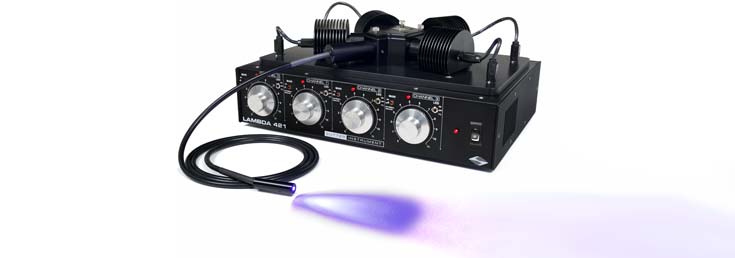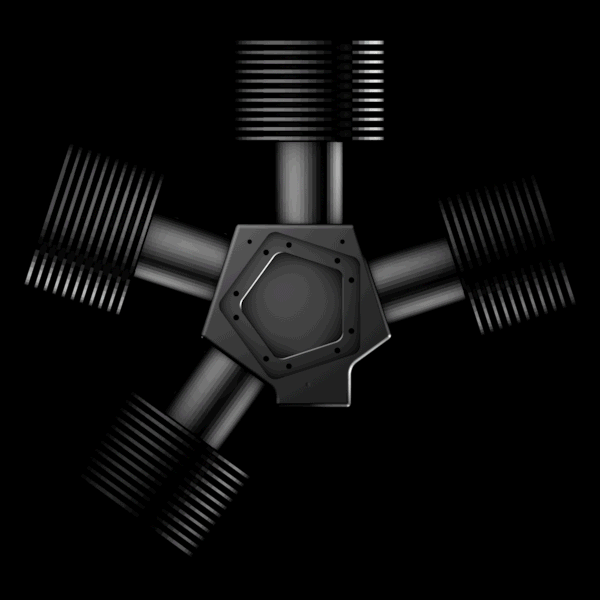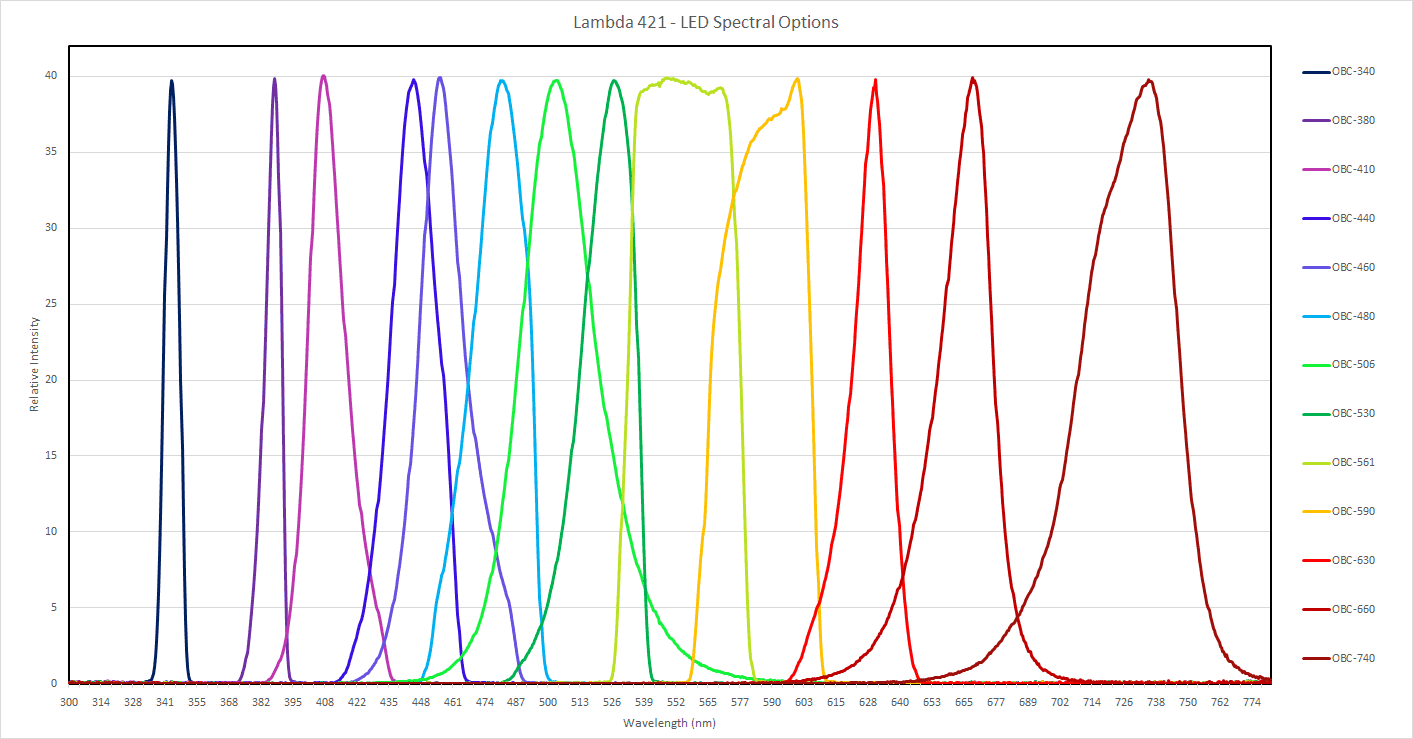
Lambda 421
Der Lambda 421 Strahlkombinierer ist ein relativ neues patentiertes Konzept zur Kombination separater Lichtquellen mit unterschiedlichen Spektren zu einem einzigen gemeinsamen Ausgangsstrahl.

Jede separate Lichtquelle wird vor dem Eintritt in den Strahlengang durch einen Bandpassfilter kollimiert. Die Filter für jede Lichtquelle fungieren auch als Spiegel, die die kollimierten Strahlen der vorherigen Lichtquellen reflektieren. In der folgenden Abbildung sind die Strahlengänge für jede Position einschließlich der auftretenden Reflexionen dargestellt:

Traditionell erforderte die Kombination von mehr als zwei Lichtquellen die Verwendung einer dichroitischen Leiter. Dichroitische Spiegel, die an einem Punkt im Spektrum von Transmission zu Reflexion wechseln, ermöglichen die Kombination separater Lichtquellen, vorausgesetzt, dass sich die Wellenlängen dieser Quellen nicht überschneiden. Der Nachteil dieses Ansatzes besteht darin, dass die Lichtquellen nicht einfach ausgetauscht werden können.
Bei dichroitischen Leitern muss außerdem sorgfältig auf die Reihenfolge geachtet werden, in der die Lichtquellen in den Strahlengang eingeführt werden, um zu vermeiden, dass das Licht durch den nächsten dichroitischen Spiegel in der Reihe blockiert wird. In der Regel müssen vor jeder Lichtquelle vor dem dichroitischen Spiegel zusätzliche Bandpassfilter angebracht werden, um den gewünschten Wellenlängenbereich für jede Quelle auszuwählen. Jeder in der Leiter verwendete Filter und dichroitische Spiegel verringert die Gesamtlichtleistung des Systems.
PRODUKTMERKMALE
- Kombinierbar mit jeder Lichtquelle
- Jeder geeignete Filter kann an einer der vier Positionen angebracht werden, ohne dass die Reihenfolge beachtet werden muss
- Wellenlängenauswahl und Strahlreflexion mit Semrock® STR-Filtern
Der Lambda 421 wurde entwickelt, um die Größe des Strahlkombinators klein und den Strahlengang kurz und effizient zu halten. Dünnschicht-Bandpassfilter, wie z. B. Semrocks STR, reflektieren mehr als 90 % des außerhalb des Bandes liegenden Lichts. Wenn sich die Bandbreiten der einzelnen Lichtquellen nicht überlappen, können die Filter sowohl zur Dämpfung als auch zur Reflexion des Lichts aus den anderen Quellen verwendet werden. Durch die Anordnung der Filter und Quellen in einem Fünfeck konnten wir vier Lichtquellen in einem kompakten Design mit geringeren Verlusten als bisher kombinieren. Als zusätzlicher Vorteil benötigt die letzte Position im Strahlengang keinen Filter, da von dieser Position aus keine anderen Eingänge reflektiert werden. Dieser Eingang kann mit jeder Art von Lichtquelle verwendet werden, solange Sie sich der möglichen Verluste bewusst sind, wenn Filter verwendet werden, die diese Lichtquelle überlappen. Die fünfte Seite des Fünfecks wird zum Ausgang für die kombinierten Quellen. Die Filter sind leicht austauschbar und werden auf kleinen Schiebern im Inneren des Fünfecks installiert. Filter und zugehörige Lichtquellen können in beliebiger Reihenfolge um das Fünfeck angeordnet werden.
Hinweise:
- Das Licht von Position 0 gelangt ohne Reflexion direkt zum Geräteausgang. Diese Position ist möglicherweise für die Quelle mit der gewünschten höchsten Leistung vorzuziehen.
- Der Filter für die vierte Lichtquelle wird nicht als reflektierende Oberfläche verwendet und kann weggelassen werden, wenn eine Breitbandquelle gewünscht ist.
- Bei Konfigurationen mit weniger als vier Lichtquellen sollten die Quellen von der niedrigsten zur höchsten Anzahl von Reflexionen gefüllt werden, um die höchste Lichtleistung zu gewährleisten.
Der Strahlengang für jeden Eingang ist um 18 Grad relativ zum Filter für diesen Anschluss geneigt. Dies führt zu einer geringen Verschiebung des Bandpasses in Richtung kürzerer Wellenlängen. Obwohl eine für diese Anwendung optimierte Beschichtung ideal wäre, haben wir festgestellt, dass Standard-STR-Filter verwendet werden können, wenn Sie die Verschiebung des Bandpasses bei der Auswahl der Filter korrigieren. Dies eignet sich für die Kombination von Schmalbandquellen wie LEDs und Lasern mit Breitbandquellen wie Bogenlampen oder Weißlicht-LEDs. Bei LEDs können die Wellenlängen mit der Geschwindigkeit der einzelnen Quelle abgeschaltet werden. Die Produkte HPX und TLED von Sutter Instrument können in 10 bzw. 25 ms umschalten, was den Lambda 421 zu einem der schnellsten, wenn nicht sogar zum schnellsten Wellenlängenumschalter auf dem Markt macht. Der Lambda Pentagon-Strahlkombinator ist auf Flexibilität und Erweiterbarkeit ausgelegt. Sollten sich Ihre Beleuchtungsanforderungen im Laufe der Zeit ändern, können Sie durch eine einfache Konfigurationsänderung und möglicherweise zusätzliche Filter eine völlig andere Ausgabe erzielen.

TECHNISCHE DATEN
Ausgangsbereich
(330 nm – 960 nm) Abhängig von den für den Einsatz ausgewählten LEDs
Verschluss
Ein-/Ausschaltzeit:
Rauschen/Kurzzeitstabilität
0,01 %
LED-Lebensdauer
> 50.000 h
Abmessungen der Steuerbox
40 cm × 27,9 cm × 19,05 cm
Gewicht
8,07 kg
Stromversorgung
120/240 V
50/60 Hz
LED-Module für Lambda 421
| Katalognummer | Beschreibung |
| OBC-340 | LED, 340 nm für den optischen Strahlkombinierer |
| OBC-365 | LED, 365 nm für den optischen Strahlkombinierer |
| OBC-380 | LED, 380 nm für den optischen Strahlkombinierer |
| OBC-385 | LED, 385 nm für den optischen Strahlkombinierer |
| OBC-410 | LED, 410 nm für den optischen Strahlkombinierer |
| OBC-440 | LED, 440 nm für den optischen Strahlkombinierer |
| OBC-460 | LED, 460 nm für den optischen Strahlkombinierer |
| OBC-480 | LED, 480 nm für den optischen Strahlkombinierer |
| OBC-506 | LED, 506 nm für den optischen Strahlkombinierer |
| OBC-530 | LED, 530 nm für den optischen Strahlkombinierer |
| OBC-561 | LED, 561 nm für den optischen Strahlkombinierer |
| OBC-590 | LED, 590 nm für den optischen Strahlkombinierer |
| OBC-630 | LED, 630 nm für den optischen Strahlkombinierer |
| OBC-660 | LED, 660 nm für den optischen Strahlkombinierer |
| OBC-740 | LED, 740 nm für den optischen Strahlkombinierer |
| OBC-850 | LED, 850 nm für den optischen Strahlkombinierer |
| OBC-940 | LED, 940 nm für den optischen Strahlkombinierer |
| OBC-W5 | LED, Weißlicht für den optischen Strahlkombinierer |
